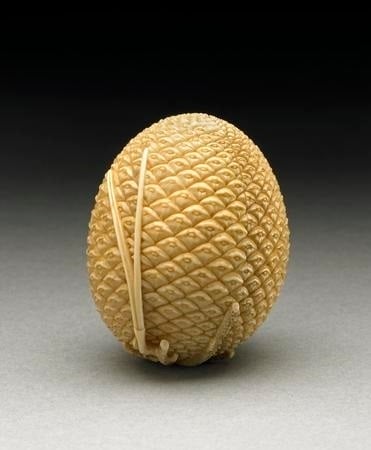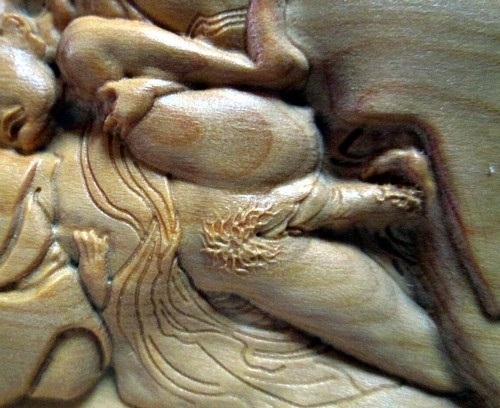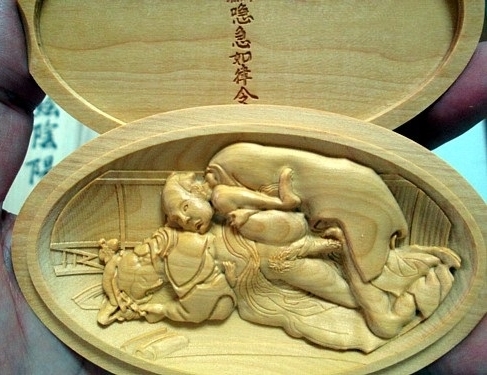
On the web, you may find thousands of examples of ukiyo-e erotic prints, but there are lots of other manifestations of eroticism in Japan besides the “laughing pictures.” As known, one of the most famous local features is netsuke, small figurines used to fix the cord with a small bag or box that was suspended on the obi since traditional Japanese wear didn't have pockets. Other objects of the local craftsmanship were okimono ("decorative object"), decorative mini sculptures to be put on display. We've discovered some curious examples of modern okimono inspired by classic shunga oeuvres.

Fig. 1. Carved shunga (page.auctions.yahoo.co.jp)
Adult Doll Play
We've discovered this small yet elegant set in the Japanese blog Adult Doll Play which refers to the platform The world of Shunga dolls with a collection of shunga dolls belonging to Araki Kazunari. Araki is a professional acupuncturist and amateur sculptor who specializes in prehistoric creatures, as he writes on his other website, devoted to dinosaurs modeling. His interests have expanded, and now, besides producing triceratops, he collects and creates different types of shunga dolls. In Araki's blog, you can find his amazing remakes of Toshio Saeki's art and some variations on Hokusai's Tako To Ama that he's seen at the auctions. Interestingly, Araki not only creates figurines but also puts his characters in the Japanese setting with distinctive furniture and shoji sliding doors.
 Fig. 2. Toshio Saeki’s original (kaiboushitu.cocolog-nifty.com)
Fig. 2. Toshio Saeki’s original (kaiboushitu.cocolog-nifty.com)

Fig. 3. Wonderful sculptural impression by Araki Kazunari (kaiboushitu.cocolog-nifty.com)

Fig. 4. The mermaid (kaiboushitu.cocolog-nifty.com)

Fig. 5. The impression of Tako To Ama, the artist is unknown (kaiboushitu.cocolog-nifty.com)

Fig. 6. Ivory cone pine, the 19th century (britishmuseum.org)

Fig. 7. The cone opened (britishmuseum.org)
Ukiyo-e Yin-Yang Harmony
The Shunga set this article is devoted to appears as six small wooden boxes packed in a larger wooden box with the title "Ukiyo-e Yin-Yang Harmony." We don't know the Japanese term for these "surprise boxes" with carved miniatures, but the similar pine cone made of ivory, the showpiece from a collection of the British Museum, is classified there as okimono (fig. 6). The cone opens to reveal an erotic scene. Unlike netsuke, it doesn't have a hole for a cord to run through and serves only for decorative purposes.

Fig. 8. Left: the box from Araki Kazunari’s blog (kaiboushitu.cocolog-nifty.com); right: the box from the auction’s site (page.auctions.yahoo.co.jp)
 Fig. 9. Left: the box from Araki Kazunari’s blog (kaiboushitu.cocolog-nifty.com); right: the image from the auction’s site (page.auctions.yahoo.co.jp)
Fig. 9. Left: the box from Araki Kazunari’s blog (kaiboushitu.cocolog-nifty.com); right: the image from the auction’s site (page.auctions.yahoo.co.jp)

Fig. 10. Small box with a carved miniature, the image from Araki Kazunari’s blog (kaiboushitu.cocolog-nifty.com)
Homage to Masters
The set can be found in two variations differing only by the pattern of the wood and the inscription pattern (both variations are made of paulownia), and also by the color of the lining of the large box (crimson or blue). Six boxes in a shape of a soap reveal six carved reproductions of Shunga oeuvres made by Hokusai, Eisen, Kuniyoshi, Kunisada, Kunitora and Utamaro. Each "soap" or "shell" has an inscription with an artist's name and the series the scene belongs to. On the Yahoo auction page, the sculptor is mentioned as Kayama Takamiya, though there's no info on a person with this name. However, the carving is not as detailed as the original prints in terms of kimono patterns, still, it's extremely accurate in reproducing genitalia with all curves and public hair that can be seen in originals. You can even recognize some artists without reading the inscription, as the carver perfectly conveyed, for instance, Hokusai's distinctive manner of depicting crumpled undergarments.

Fig. 11. Close photo taken from Araki Kazunari’s blog (kaiboushitu.cocolog-nifty.com)

Fig. 12a. Utamaro, Ehon Komachi-biki (ukiyo-e.org)

Fig. 12b. Carved impression of Utamaro’s shunga (kaiboushitu.cocolog-nifty.com)

Fig. 12c. Closer image (kaiboushitu.cocolog-nifty.com)

Fig. 13a. Hokusai, Young Pines (Kinoe No Komatsu)

Fig. 13b. Carved impression of Hokusai’s design (kaiboushitu.cocolog-nifty.com)

Fig. 14a. Kuniyoshi’s Edo nishiki-e azuma bunko, ca. 1838 (akantiek.nl)

Fig. 14b. Carved impression of Kuniyoshi’s shunga (kaiboushitu.cocolog-nifty.com)

Fig. 15a. Keisai Eisen, Spring finger doll (jp.mercari.com)

Fig.15b. 'Shunho Yaezakura' (c.1840) attributed to Hiroshige

Fig. 15c. Carved impression of Keisai Eisen's shunga (kaiboushitu.cocolog-nifty.com)

Fig. 16a. Utagawa Kunitora's print (kaiboushitu.cocolog-nifty.com)

Fig. 16b. Carved impression of Kunitora's print (kaiboushitu.cocolog-nifty.com)

Fig. 17a. Gay shunga by Kunisada from 'Shunshoku koi no teryiri' series (akantiek.nl)

Fig. 17b. Carved impression of Utagawa Kunisada's print similar to the print above (kaiboushitu.cocolog-nifty.com)
Why Nuts?
The current article contains a reference to nuts because the carved wooden okimono boxes have an analog in the European tradition of gothic boxwood miniature. Most examples of this art are spherical rosary beads, also known as prayer nuts, majorly produced in the Netherlands in the 16th century. Their sizes vary between a walnut and a golf ball. Many known prayer nuts were produced by the Dutch sculptor Adam Dircksz. The beads reveal the episodes of the life of Christ, frequently, the Passion scenes. The degree of detail is what makes these works of art truly unique yet absolutely impractical because a prayer needs a magnifying glass to fully appreciate the sculptural composition.

Fig. 18. Prayer Bead with the Adoration of the Magi and the Crucifixion (wikimedia.org)

Fig. 19. Prayer Bead with the Adoration of the Magi and the Crucifixion opened (wikimedia.org)

Fig. 20. Half of a Prayer Bead with the Lamentation (Wikipedia.org)
Sources: The world of Shunga dolls (dinodino9.wixsite.com/syungadoll); The blog of the platform: kaiboushitu.cocolog-nifty.com; The world of Araki Kazunari dinosaur’s model (dinosaurs.art.coocan.jp); Wikipedia.org
Click HERE for an article on a striking shunga statue on a classic 'harbor' scene by the ukiyo-e artist Keisai Eisen
